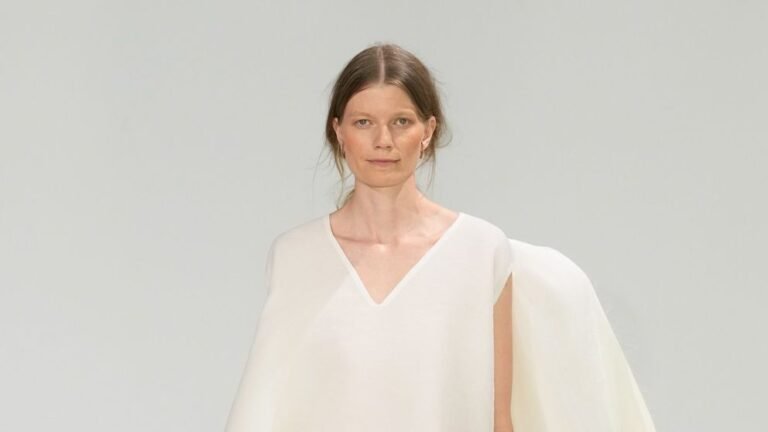Freya Dalsjø’s triumphant return to the runway was a “take me to church” moment quite apart from being held in Nikolaj Kunsthal, Copenhagen Fashion Week’s newly inaugurated hub, which was in fact once a place of worship. Her slow-paced collection, which had a sense of procession to it, was a hymn to craftsmanship, a paean to materials, and a kind of rebirth.
Dalsjø started her business in 2012 when she returned to Denmark to develop her skills after failing the course at the Royal Academy of Arts in Antwerp. Over the years she’s received support from the Danish Arts Foundation, and has again this year. With the onset of Covid in 2020 she stepped away from the catwalk: “I needed to rethink how I wanted to do things,” she explained. Based on her past collections, that recalibration related not just to business but also to aesthetics. The collection she presented today was refined to the point of purity. Not that it was in any way clinical, but every piece was pared back as to be essential. These are clothes, many based on simple shapes and extraordinary proportions, that truly merit the adjective timeless.
Opening the show was an earth angel in a raw-edged “paper” dress of silk gazar and crepon that meringued around the body and was even more heavenly in back than front. A double-faced gray cashmere lapeled scarf had the simplicity of vestments. Many outfits gently protected the body by cocooning it, yet there were moments of exuberance, as in a series of leather pieces cut into strings with painted tips that resembled bobbing stamens.
Geometry became poetry when hundreds of leather squares connected at the corners leaving little cutouts that were worked into a cape and skirt. This idea was also repeated with handcarved pieces of wood that made music as the model walked. Zoom into a pair of chocolate colored lambskin pants and you’ll see almost imperceptible folds. The spontaneous chaos of nature was captured in woven pieces, one of which resembled lichen covered bark. The woven basketry pieces that closed the show referenced Danish and Japanese craft traditions.
Like Phoebe Philo, Dalsjø creates clothes for women, not girls, which is rarer than you might imagine. This collection was about time—not trying to capture or stop it, but to luxuriate in it, and to lose oneself to it, imaging the flow state that might be achieved with such intricate artisanship. “Every piece is so time consuming, but I think it’s really, really worth it, and that’s really what I love doing, trying to explore and create special techniques and crafts and figuring out how to use the material in new interesting ways and create interesting textures,” Dalsjø said.
Then there is the fact that the designer has come back into the public eye on her own terms after a pause. She’s one of three women to do so on the spring schedule here, which seems pretty remarkable given the disparity between female and male creative directors.
“Looking back on the years, it takes a long time to know what you really want and also to get the skill set,” noted Dalsjø. The designer is an advocate of slow fashion. “I think you can sense that in the collection, both in terms of all the craftsmanship, but also the silhouettes are generally quite relaxed and very comfortable and I think the materials are really comfortable on your skin,” she said. “It’s important [to have] clothes that you can move in and that you can breathe in.”
